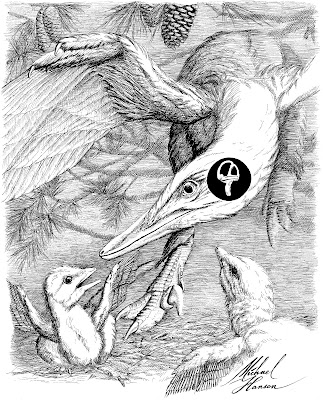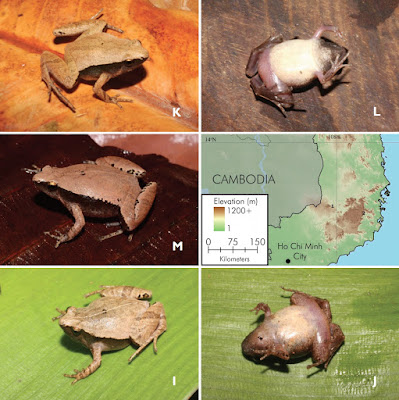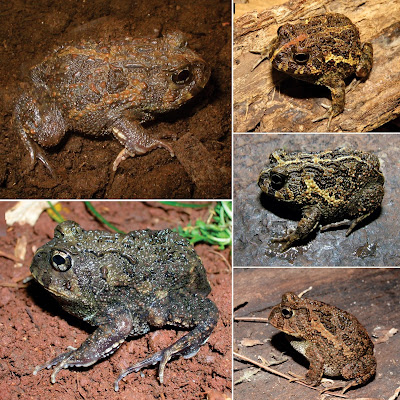[Most Recent Entries] [Calendar View]
Monday, May 10th, 2021
| Time | Event | ||
| 6:55a | [Paleontology • 2021] The Early Origin of A Birdlike Inner Ear and the Evolution of Dinosaurian Movement and Vocalization
 Abstract Reptiles, including birds, exhibit a range of behaviorally relevant adaptations that are reflected in changes to the structure of the inner ear. These adaptations include the capacity for flight and sensitivity to high-frequency sound. We used three-dimensional morphometric analyses of a large sample of extant and extinct reptiles to investigate inner ear correlates of locomotor ability and hearing acuity. Statistical analyses revealed three vestibular morphotypes, best explained by three locomotor categories—quadrupeds, bipeds and simple fliers (including bipedal nonavialan dinosaurs), and high-maneuverability fliers. Troodontids fall with Archaeopteryx among the extant low-maneuverability fliers. Analyses of cochlear shape revealed a single instance of elongation, on the stem of Archosauria. We suggest that this transformation coincided with the origin of both high-pitched juvenile location, alarm, and hatching-synchronization calls and adult responses to them. Michael Hanson, Eva A. Hoffman, Mark A. Norell and Bhart-Anjan S. Bhullar. 2021. The Early Origin of A Birdlike Inner Ear and the Evolution of Dinosaurian Movement and Vocalization. Science. 372, 6542. 601-609. DOI: 10.1126/science.abb4305 Jonah N. Choiniere, James M. Neenan, Lars Schmitz, David P. Ford, Kimberley E. J. Chapelle, Amy M. Balanoff, Justin S. Sipla, Justin A. Georgi, Stig A. Walsh, Mark A. Norell, Xing Xu, James M. Clark and Roger B. J. Benson. 2021. Evolution of Vision and Hearing Modalities in Theropod Dinosaurs. Science. 372, 6542; 610-613. DOI: 10.1126/science.abe7941 Revealing behavioral secrets in extinct species Extinct species had complex behaviors, just like modern species, but fossils generally reveal little of these details. New approaches that allow for the study of structures that relate directly to behavior are greatly improving our understanding of the lifestyles of extinct animals (see the Perspective by Witmer). Hanson et al. looked at three-dimensional scans of archosauromorph inner ears and found clear patterns relating these bones to complex movement, including flight. Choiniere et al. looked at inner ears and scleral eye rings and found a clear emergence of patterns relating to nocturnality in early theropod evolution. Together, these papers reveal behavioral complexity and evolutionary patterns in these groups. | ||
| 7:03a | [Herpetology • 2021] Microhyla daklakensis & M. ninhthuanensis • Two New Cryptic Species of Microhyla Tschudi, 1838 (Anura, Microhylidae) related to the M. heymonsi Group from central Vietnam Abstract The Microhyla heymonsi species complex from central Vietnam was examined, and based upon morphological and molecular evidence, two new species are described. The discovery of Microhyla daklakensis sp. nov. and Microhyla ninhthuanensis sp. nov. brings the total number of known species in the genus to 46 and the species number of Microhyla in Vietnam to 13. The Truong Son Range harbors the highest diversity of the genus Microhyla with 11 recorded species so far. However, this apparent micro-endemic diversity is at risk because of habitat loss by deforestation, which highlights the necessity of further research leading to improved conservation measures. Keywords: Microhyla, new species, central Vietnam, morphology, molecular phylogeny Microhyla ninhthuanensis sp. nov. Diagnosis: Microhyla ninhthuanensis sp. nov. is distinguished from its congeners by a combination of the following morphological characters: 1) body stocky, size medium (SVL 17.3–18.8 mm, n = 9 males; 21.6–23.6 mm, n = 2 females). 2) dorsum smooth; 3) head triangular, snout round in profile; 4) finger I shorter than one-half the length of finger II; 5) tips of all outer fingers dilated, forming disks, with a median longitudinal groove visible dorsally; 6) tips of all toes distinctly dilated into disks, with a weak median longitudinal groove visible dorsally, producing the appearance of two scutes; 7) inner metacarpal tubercle oval and prominent, paired outer metacarpal tubercle divided by a waist into two equal-sized parts: outer part quite round, inner part quite crescent; 8) tibiotarsal articulation of straightened limb not reaching snout; 9) webbing basal: I2 – 2½II2 – 3III3 – 4IV4⅓ – 3V; 10) inner metatarsal tubercles oval, prominent and outer metatarsal tubercles round; 11) upper eyelid without supraciliary spines; 12) narrow faint brown stripe extending from rear corner of eye to axilla; 13) light thin vertebral stripe present, canthus rostralis with dark lines; 14) small dark round spot at mid-dorsum, divided by a light vertebral stripe; 15) dorsum pinkish brown with dark brown marking in X-shape between eyes and arm, along vertebral and dorsolateral region stripes form wavy dust strip towards the groin, a small dark marking ‘ ()’-shaped in the center of the dorsum and mid-dorsal line; 16) an even black lateral stripe from above arm, almost reaching groin; 17) chin dark grey; throat white with scattered dark grey dusting; chest and belly creamy white. Etymology: Specific epithet is in reference to the type locality, Ninh Thuan Province. We recommend “Ninh Thuan narrow-mouth frog” as the common English name and “Nhái bầu ninh thuận” as the Vietnamese name. Natural history: All specimens were collected at night from 19:00 to 23:00 h on the ground near the banks of a small stream in the forest and on the sides of a recently constructed road next to the devastated forests (Fig. 6B). Larval stages and eggs of the new species are unknown. Distribution: Microhyla ninhthuanensis sp. nov. is currently only known from the type locality in Phuoc Binh National Park, Ninh Thuan Province, Vietnam (Fig. 1). The species was recorded at an elevation of ca. 300 m a.s.l. Microhyla daklakensis sp. nov. Diagnosis: (1) Microhyla daklakensis sp. nov. is distinguished from its congeners by a combination of the following morphological characters: 1) body stocky, size medium (SVL 17.7–20.1 mm n = 4 males; 21.1–23.8 mm, n = 6 females), 2) dorsum smooth; 3) snout round in profile; 4) finger I longer than one-half the length of the finger II; 5) tips of all outer fingers dilated, forming disks, with a median longitudinal groove visible dorsally; 6) tips of all toes distinctly dilated into disks, with a weak median longitudinal groove visible dorsally, producing the appearance of two scutes; 7) inner metacarpal tubercle oval and prominent, paired outer metacarpal tubercle divided by a waistline into two equal-sized parts: outer part quite round, inner part crescent-shaped; 8) tibiotarsal articulation of straightened limb not reaching snout; 9) webbing basal: I2 – 2½II2 – 3III3 – 4IV4⅓ – 3V; 10) inner metatarsal tubercles oval, prominent and outer metatarsal tubercles round; 11) upper eyelid without supraciliary spines; 12) narrow faint brown stripe extending from rear corner of eye to axilla; 13) thin, pale vertebral stripe present, canthus rostralis with dark lines; 14) small dark round spot at mid-dorsum, divided by a light vertebral stripe; 15) dorsal surface yellowish brown, a dark brown marking in V-shape between eyes to insertion of arms; 16) vertebral and dorsolateral stripes form wavy dust strip towards the groin; 17) a small dark marking in ‘ ()’-shape on the center of the dorsum and mid-dorsal line; 18) an evenly colored black lateral stripe from above the insertion of the arms, almost reaching groin; 19) chin dark grey; throat white with scattered dark grey dusting; chest and belly creamy white. Etymology: Specific epithet is in reference to the type locality, Dak Lak Province. We recommend “Dak Lak narrow-mouth frog” as the common English name and “Nhái bầu dak lak” as the Vietnamese name. Natural history: All specimens were collected at night from 19:00 to 23:00 h on the ground near the banks of small temporary ponds formed after heavy rain, along the edges of the forest and on the sides of a recently constructed road next to the devastated forests (Fig. 6A). The new species was found in sympatry with four congeners including M. berdmorei, M. butleri, M. mukhlesuri, and M. pulchra, all of which were reproducing simultaneously with the new species in the same breeding site. Other anurans such as Fejervarya limnocharis, Occidozyga cf. lima, and Occidozyga martensii also occurred in sympatry. Larval stages and eggs of the new species are unknown. Distribution: Microhyla daklakensis sp. nov. is currently known only from the type locality in Nam Ka Nature Reserve, Krong No District, Dak Lak Province, Vietnam (Fig. 1). The species was recorded at an elevation of ca. 500 m a.s.l. Chung Van Hoang, Tao Thien Nguyen, Hoa Thi Ninh, Anh Mai Luong, Cuong The Pham, Truong Quang Nguyen, Nikolai L. Orlov, Youhua Chen, Bin Wang, Thomas Ziegler and Jianping Jiang. 2021. Two New Cryptic Species of Microhyla Tschudi, 1838 (Amphibia, Anura, Microhylidae) related to the M. heymonsi Group from central Vietnam. ZooKeys. 1036: 47-74. DOI: 10.3897/zookeys.1036.56919 | ||
| 10:00a | [Herpetology • 2021] Odontophrynus reigi • A New Burrowing Frog of the Odontophrynus americanus Species Group (Anura, Odontophrynidae) from Subtropical Regions of Argentina, Brazil, and Paraguay
Abstract A new species of frog of the genus Odontophrynus is described from grassland of the subtropical regions of Argentina, Brazil, and Paraguay based on morphological, osteological, bioacoustical, cytogenetic, and molecular evidence. The new species is characterized by having medium size; rostral and eye-nostril glandular warts well developed; several long glandular ridges, longitudinally oriented, on dorsum; several medium-sized, nearly rounded, dark-brown dorsal blotches; light mid-dorsal stripe continuous and well defined or restricted to the head and the urostyle regions; and mid-dorsal stripe, interorbital, and dorsolateral bands with a moderately whitish highlight, light brown, or reddish coloration. Additionally, the new species has a skull with nasals slightly separated both from each other and frontoparietals, and frontoparietal fontanelle not exposed. The advertisement call consists of a single multipulsed note with a dominant frequency of 820–1,121 Hz and a pulse rate of 99.3–140.7 pulses/s. The chromosomal complement is diploid with 2N = 2X = 22 chromosomes and nucleolar organizer regions on the interstitial regions of the short arm of chromosome pair 4. The phylogenetic analysis allowed us to recover the new species belonging to the O. americanus species group with genetic distances from its congeners ranging from 2.11 to 4.82% in a partial sequence of 16S ribosomal RNA gene. The new species is geographically isolated from the other currently known diploid species of the group, but in some localities is found in sympatry or syntopy with the tetraploid O. americanus. Odontophrynus reigi, new species Etymology.—The specific epithet honors Osvaldo Alfredo Reig (Buenos Aires, Argentina, 1929–1992) for his noteworthy contributions to the biological sciences of South America (Reig and Fontdevila, 1989; Boido and Tenner, 1991; Fontanals, 2012). He published more than 200 studies on morphology, anatomy, cytogenetics, paleontology, and systematics of amphibians, reptiles, and mammals. Regarding amphibians, Reig proposed the suborder Neobatrachia, and described two of the oldest known species of frogs, Notobatrachus degiustoi and Vieraella herbsti, from the Jurassic of Patagonia, Argentina. He worked at Universidad de Buenos Aires and Instituto Miguel Lillo (Argentina), Universidad Simón Bolívar (Venezuela), and Universidad Austral (Chile), among other academic centers, where he was strongly committed to scientific development, education of young researchers, and consolidation of working groups. Sadly, he had to go into exile from Argentina and Chile due to coups d’etat. In 1973, Reig received his Ph.D. in Zoology and ´ Paleontology from the University of London. In 1989, the Universidad Autonoma de Barcelona named him as Doctor ´ Honoris Causa. Sergio D. Rosset, Renata Moleiro Fadel, Carla da Silva Guimarães, Priscila Santos Carvalho, Karoline Ceron, Mariana Pedrozo, Renata Serejo, Victória dos Santos Souza, Diego Baldo and Sarah Mângia. 2021. A New Burrowing Frog of the Odontophrynus americanus Species Group (Anura, Odontophrynidae) from Subtropical Regions of Argentina, Brazil, and Paraguay. Ichthyology & Herpetology. 109(1); 228-244. DOI 10.1643/h2020056 |
| << Previous Day |
2021/05/10 [Calendar] |
Next Day >> |













